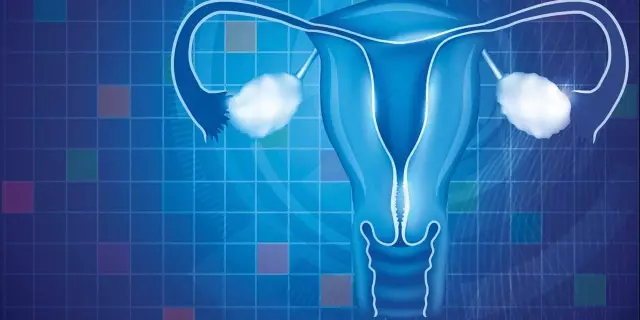- Author Rachel Wainwright [email protected].
- Public 2023-12-15 07:39.
- Last modified 2025-11-02 20:14.
Anti-Müllerian hormone

Both men and women can suffer from infertility. Identification of infertility and its causes is a very complex procedure that includes many different examinations and tests. A mandatory analysis is also the determination of the Müller inhibitory substance, or, as it is also called, the anti-Müllerian hormone (AMH). Its indicators play an important role in the application of additional reproductive technologies (in vitro fertilization or artificial insemination). Also, AMH is determined for a number of other diseases and abnormalities.
What are Müllerian ducts?
Müllerian ducts are such paired channels that form at 7-8 weeks of embryo development. In women, the upper part of the vagina, fallopian tubes and uterine epithelium are subsequently formed from the Müllerian ducts. In men, they atrophy and, under the influence of the anti-Müllerian hormone, regress into the prostatic uterus. Atrophy of the Müllerian ducts is a long process that continues until puberty in boys.
One of the rare disorders of intrauterine development of male embryos is persistence syndrome of Müllerian ducts (Müllerian duct syndrome). This is a rather rare form of false male hermaphroditism, which occurs as a result of atrophy of the Müllerian ducts, which leads to the formation of the fallopian tubes and the upper part of the vagina. At the same time, the male karyotype remains - 46, XY.
What is anti-Müllerian hormone?
Anti-Müllerian hormone (AMH) is a dimeric glycoprotein belonging to the family of beta-transforming growth factors. During the development of the embryo, this hormone is secreted by Sertoli cells, and in men it is responsible for the atrophy of the Müllerian ducts. Until puberty, AMH is secreted by the testes. Gradually, with the age of the man, its level decreases to the residual post-pubertal values. If the function of the anti-Müllerian hormone is disturbed in men, then the derivatives of the Müllerian ducts are preserved, which is clinically expressed in impaired reproductive function, cryptorchidism, and the occurrence of inguinal hernias. Despite the fact that with this syndrome the differentiation of the testicles is not disturbed, infertility is often observed in men.
In women, AMH is secreted by ovarian granulosa cells from birth to menopause. Compared to men, women have lower levels of anti-Müllerian hormone until puberty. After its onset, the AMH level gradually decreases to generally undetectable values.
In women, AMH is

produced in the granulosa cells of the primary follicles, and its highest concentration is observed in the antral and preantral follicles with a diameter of 4 mm, while this hormone is not present at all in the dominant follicles. After maturation of one of the follicles, the synthesis of AMG decreases. In women, anti-Müllerian hormone performs two functions at once: it suppresses the primary stages of follicular growth and inhibits the growth of small antral and preantral follicles. Since AMH does not respond to the influence of gonadotropic hormones (LH and FSH), its level is used to determine the ovarian reserve of the ovaries. If the level of anti-Müllerian hormone is lowered, this indicates a decrease in the ovarian reserve of the ovaries.
Indications for the determination of anti-Müllerian hormone
The definition of AMH plays an important role in the diagnosis of various diseases of women and men. The range of indications for determining AMG is quite wide:
- delayed sexual development;
- diagnostics of premature sexual development;
- finding out the ovarian reserve of the ovaries (important before artificial insemination or in vitro fertilization);
- during chemotherapy;
- diagnosis and monitoring of the treatment of granulosa cell tumor of the ovary;
- the presence of anorchism and cryptorchidism;
- problems with conception;
- determination of the presence of testicular tissue;
- high or marginal concentrations of follicle-stimulating hormone;
- infertility with an unexplained cause;
- unsuccessful attempts at in vitro fertilization or poor response to ovarian stimulation;
- assessment of the sexual function of men of any age;
- assessment of the success of antiandrogen therapy.
Anti-Müllerian hormone rates
- In women, the norm of anti-Müllerian hormone is 0.49-5.98 ng / ml.
- In men, the AMH norm is 1.0-2.5 ng / ml.
Women undergo research, as a rule, on the 3-5th day of the cycle. For men - at any time. Three days before blood sampling, it is necessary to exclude intense physical activity and any stressful situations. The study is not carried out during the period of acute illness.
As a rule, the patient receives the finished results in his hands two days after taking the blood.
What does it mean when the anti-Müllerian hormone is elevated?
When the anti-Müllerian hormone is elevated, this may indicate the presence of the following diseases:
- delayed sexual development;
- polycystic ovary disease;
- LH receptor abnormalities;
- tumors in ovarian granulosa cells;
- bilateral cryptorchidism;
- antiandrogen therapy;
- normogonadotropic anovulatory infertility.
What does it mean when the anti-Müllerian hormone is lowered?
- menopause;
- anarchism;
- hypogonadotropic hypogonadism;
- obesity;
- premature sexual development;
- dysgenesis of the gonads.
Found a mistake in the text? Select it and press Ctrl + Enter.






